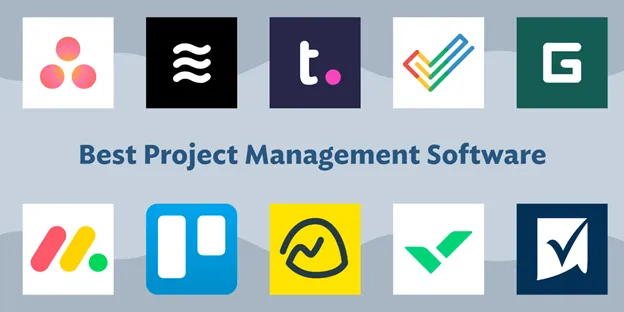Business
Best Project Management Software for Teams in 2024

Introduction
Best Project Management Software for Teams to be organized, set goals and meet the set goals and durations on time. Chief among these topics is the role of project management software in an organizational environment that is rapidly turning into an extended work from home or a hybrid model. That is why the appropriate tool will help to organize communication and track tasks, guaranteeing the efficiency of the work of teams.
As of 2024, there are several project management tools, their characteristics, and conveniences, and their scalability. Irrespective of the size of the team, whether it is big or small there is software for everyone. This article aims to provide a guide to the measures that shall be taken in the selection process of project management software for the teams in the year 2024.
1. Monday.com
Overview
Monday.com can be characterized as one of the most multifunctional tools for managing projects. It has a good graphical design and is easy to use for the user in tracking their progress. However, it is most suitable for larger groups; it has versatile features on workflows and integration with automation.
Key Features
- Flexible Process – Organise project boards in a flexible manner according to the requirements of the team and project.
- Automations – This is ways for the reduction on manual work when performing repetitive chores.
- Integrations – Connect with Slack, Zoom, Microsoft Teams, and more.
- Tracking – Track working amount of time with regards to time allocation in carrying out tasks.
- Templates – templates specifically for marketing or technology, human resources, and others.
Pricing
- Free plan available for up to two users.
- The paid subscriptions are available at $8 per month for each user for the basic plan.
Pros & Cons
Easy to use and the ability to customize the platform. The tool allows for a good amount of automation. The price increases based on the size of the team. Some features may require more training and familiarization.
2. Asana
Overview
Asana is a tool for managing tasks that is suitable for those teams that require some structure but need to be adaptable at the same time. To be precise, using this software may enhance how teams work together control tasks, evaluate progress and much more.
Key Features
- Task Links – Define how tasks relate with each to ensure that every task in a project progresses in the right order.
- Schedules – Organize them with the help of Gantt charts in order to represent the timelines.
- Work Flow Builder – This saves time through automation of activities.
- Multiple Views – You may see the list, board, calendar, and timeline views.
Features such as commenting on the tasks, the possibility to add files, and the role assignment.
Pricing
- Free plan available for individuals and small teams.
- Premium plan costs $10.99 per user per month, while the business plan is for $19.99 per user per month.
Pros & Cons
It provides good opportunities to share workload and work in teams. It has good tools for reporting and visualization of time distribution. It may be confusing for those who use it for the first time. In case with quests, there is not enough opportunities in the free version and some from the paid one.
3. Trello
Overview
Trello is indeed an easy-to-use tool that uses the concepts of Kanban board for project management. Thus, in order to achieve better results it is possible to recommend this application for the teams, who look for a quick and easy to use tool for task tracking and collaboration.
Key Features
- boards – As the name suggests the ability to move tasks from one list to another with just one drag and drop operation.
- Power-Ups – Extend functionality with automation and integrations.
- List & label – Subtasks are defined and tasks are categorized and named.
- Mobile Access – This enables control of projects irrespective of the device used.
- Teamwork – Have boards of diffusion to be shared with other members of work.
Pricing
Free plan with basic features.
The plans offered for the paid version of the app are as follows; basic costs $5 per user per month.
Pros & Cons
There are also its pros and cons: Insta own without any problem. Good for small team and startups. ❌ It has a very simple design without a lot of functions for report and monitoring time. ❌ It can not for big project.
4. ClickUp
Overview
ClickUp is a project management software that offers a lot of features that center on task management, document sharing, and goal setting. It is highly versatile and can be applied to every type of work team.
Key Features
- Task Lists & Sub-tasks – Organizations should divide the tasks into subtasks and have sub-checklists for some of the larger tasks.
- Multiple Views – This is rendered in List view, Board view, Calendar view, Gantt chart view among others.
- Docs & Wikis – Utilizing this tool, users can merge document storing and the knowledge base into one program.
- Time Manage mentoring – Track time to certain tasks.
- When it comes to automated governance, the most vital function is contained in these sectors
- AI-Powered Automation – Smart automation for repetitive tasks.
Pricing
- Free plan with core features.
- Free version is available, but for paid solutions, pricing starts from $7 per user monthly.
Pros & Cons
A number of features. Its pricing model is quite reasonable. Too many options. A bit complex for users who start with this tool.
5. Wrike
Overview
Wrike is a project management software that is geared towards larger companies as well as business that is expanding. It also performs collaboration and reporting quite nicely, which is a big plus for a team rather than an individual.
Key Features
- Custom Workflows – Automate task movement and approvals.
- Advanced Reporting – A feature that allows users to develop high-quality analytics and reports.
- Gantt Charts – Track project progress visually.
- Resource Management – Allocate resources efficiently.
Integrations – You can connect with more than 400 apps and such popular platforms as Salesforce and Slack.
Pricing
- Free plan available for small teams.
- Freemium is a model in which some services are free of charge whereas some services are charged based on a subscription fee that starts at $9.80 per user per month.
Pros & Cons
Excellent for large teams and enterprises. Strong reporting and automation features. Expensive for small businesses. Complex setup process.
6. Notion
Overview
Notion is a unique tool that is part way between a project management tool, a note-taking tool and a collaboration tool. It is versatile, and this makes it fit for use by any creative team, freelancers, or a startup.
Key Features
- Personal Databases – Possibility to work with tasks, wikis and projects in the application.
- Drag-and-Drop Interface – Move elements around easily.
- Templates & Blocks – This is a feature that comprises of ready to use templates for various workflows.
- Team Collaboration – All changes that occur during the process of writing the paper can be done simultaneously with the inclusion of comments on the pages.
- Kanban, Table, Calendar – How to see projects Kanban, Table, and Calendar are three ways of observing project’s progress.
Pricing
- Free plan available with limited features.
- Starting from enhanced plans, the cost is $8 for each user per month.
Pros & Cons
Pipedrive has flexibilities and is suitable for documentation processes. It is pocket-friendly especially for a small working team. Lacking some project tracking features. Not suitable for complex projects.
Conclusion
The best software for project management depends on the number of people that you have in your team, the nature of the projects that your team works on and the amount of money that you are willing to spend on handling your projects.
The two tools, Monday.com and Asana are perfect for mid-sized teams as they provide structure. While Trello is pretty straightforward and simple, ClickUp comes with a lot of features. Wrike is suitable for large organizations, and Notion works best when its primary use is documentation.
Assess about the exact need of the team before being completely influenced by it and always make use of the trial version. The following outlines that an opportunity to invest in the right tool will result to efficiency ,collaboration and overall success of the project in the year 2024.
Business
Executive Coaching for Professional Growth | A Complete Comprehensive Guide

Introduction to Executive Coaching
What Is Executive Coaching?
Executive coaching is like having a personal trainer for your professional life — except instead of lifting weights, you’re lifting your leadership game. It’s a structured, goal-oriented process where a coach works with you one-on-one to unlock your potential, sharpen your skills, and tackle workplace challenges.
While traditional training dumps information on you, executive coaching is more like a mirror — reflecting your strengths, revealing blind spots, and helping you take action to grow.
The Rise of Coaching in Professional Development
Over the last decade, executive coaching has gone from a luxury for top CEOs to a standard tool for ambitious professionals at all levels. As the business world gets faster, more complex, and more competitive, leaders need more than just experience — they need guidance, perspective, and strategies that work in real time.
That’s where Pedrovazpaulo Executive Coaching steps in, offering tailored solutions for today’s leadership challenges.
Why Executive Coaching Matters in Today’s Workplace
Navigating Leadership Challenges
The higher you climb in your career, the more complex your problems become. Leadership isn’t just about calling the shots — it’s about navigating conflicts, driving innovation, and leading teams through uncertainty. An executive coach helps you untangle those problems and make decisions with clarity.
Bridging the Gap Between Potential and Performance
We’ve all met leaders who have the talent but struggle to deliver consistent results. Coaching bridges that gap. It aligns your abilities with actionable strategies, so you’re not just capable — you’re effective.
Through Pedrovazpaulo Executive Coaching, many professionals find the clarity and tools they need to turn potential into measurable success.
The Role of Pedrovazpaulo Executive Coaching
What Sets Pedrovazpaulo Apart
Unlike one-size-fits-all programs, Pedrovazpaulo Executive Coaching focuses on deep personalization. Every leader has unique challenges, strengths, and ambitions. The program tailors its approach to your specific needs rather than forcing you into a cookie-cutter formula.
Tailored Strategies for Individual Success
From mastering high-stakes negotiations to building emotional intelligence, Pedrovazpaulo’s methods are grounded in proven leadership principles while remaining flexible enough to adapt to changing business landscapes.
Key Benefits of Executive Coaching
Improved Decision-Making Skills
Good leaders make decisions. Great leaders make the right decisions — even under pressure. Coaching sharpens your analytical skills, helps you weigh risks, and guides you toward choices that align with both short- and long-term goals.
Strengthened Communication and Interpersonal Skills
Leadership without communication is like a car without fuel — it’s not going anywhere. Executive coaching helps you speak with clarity, listen actively, and connect authentically with employees, clients, and stakeholders.
Building Confidence in Leadership Roles
Ever notice how confident leaders inspire trust? Coaching builds that confidence not through empty motivation but by giving you the skills and self-awareness to lead decisively.
The Executive Coaching Process
Assessment and Goal Setting
Your journey usually begins with a deep dive into your current performance and career aspirations. Think of it like a GPS — you can’t plan the route if you don’t know your starting point.
Personalized Action Plans
Once goals are clear, your coach creates a roadmap designed just for you. This isn’t about following generic tips from leadership books — it’s about actionable steps tied to your reality.
Continuous Feedback and Adjustments
Growth isn’t a straight line. A good coach monitors your progress, gives real-time feedback, and adjusts strategies to keep you moving forward.
Who Can Benefit from Executive Coaching?
C-Suite Executives
Even seasoned leaders hit roadblocks. Coaching offers a confidential space to explore challenges and refine strategies.
Mid-Level Managers with Growth Potential
If you’re on the fast track to senior leadership, coaching can prepare you for the leap — making sure you don’t just get promoted but thrive in your new role.
Entrepreneurs and Business Owners
Running a business can be lonely. An executive coach becomes a trusted sounding board, helping you make decisions with confidence.
Common Myths About Executive Coaching
“It’s Only for Struggling Leaders”
This is like saying the gym is only for people who are out of shape. Many high-performing leaders use coaching to stay sharp, not just to fix problems.
“Coaching Produces Instant Results”
Coaching is powerful, but it’s not magic. Real change takes time, practice, and commitment — just like building any other skill.
How to Choose the Right Executive Coach
Credentials and Experience
Look for coaches with a proven track record and relevant industry experience. With Pedrovazpaulo Executive Coaching, you get professionals who’ve walked the leadership path themselves.
Coaching Style and Compatibility
The best coach for you is one you can trust and communicate with openly. Chemistry matters — if the relationship isn’t strong, the results won’t be either.
Integrating Coaching into Organizational Culture
Encouraging a Growth Mindset
Companies that value coaching foster a culture where feedback is welcomed, challenges are embraced, and learning never stops.
Aligning Coaching Goals with Company Objectives
For maximum impact, coaching should support your organization’s mission — not just personal ambitions.
Measuring the ROI of Executive Coaching
Performance Metrics and KPIs
From revenue growth to employee engagement scores, clear metrics help measure the tangible benefits of coaching.
Long-Term Impact on Business Success
While short-term wins are great, the true ROI shows up in sustained performance, stronger teams, and better leadership pipelines.
Conclusion – Investing in Your Professional Growth
Executive coaching isn’t just a career upgrade — it’s an investment in the leader you’re becoming. Whether you’re navigating complex challenges or aiming for the next big step in your career, the right guidance can make the journey smoother and more rewarding.
With Pedrovazpaulo Executive Coaching, you’re not just getting advice — you’re gaining a partner in your professional growth. And in today’s fast-paced, ever-changing workplace, that’s a competitive edge you can’t afford to ignore.
FAQs About Executive Coaching for Professional Growth
What’s the difference between mentoring and executive coaching?
Mentoring is usually advice-based from someone with more experience in your field, while coaching focuses on unlocking your potential through structured strategies and self-discovery.
How long does an executive coaching program last?
Programs can range from a few months to over a year, depending on your goals and needs.
Can executive coaching help with career transitions?
Absolutely. Coaching is especially valuable during transitions, helping you adapt and perform in new roles.
Is Pedrovazpaulo Executive Coaching available online?
Yes, many sessions are available virtually, making it easy to connect from anywhere.
How do I know if executive coaching is right for me?
If you’re aiming to improve your leadership skills, navigate challenges, or reach ambitious goals, coaching could be a great fit.
Business
Affordable Executive Coaching – Unlock Your Leadership Potential

Introduction – Why Executive Coaching Is No Longer a Luxury
Once upon a time, executive coaching was seen as an exclusive perk reserved for the corner-office elite—those with sprawling offices, private assistants, and an expense account big enough to rival a small country’s GDP. But those days are over.
Today, executive coaching is more accessible than ever, and that’s a very good thing. You don’t have to be a Fortune 500 CEO to benefit from leadership guidance. Mid-level managers, small business owners, and even early-stage entrepreneurs are discovering the power of professional coaching without draining their budgets.
The Old Myth: Only for Top CEOs
For decades, coaching was a high-priced, elite service. The thinking was simple: big decisions require big investments. While that’s partly true, it also meant a lot of capable leaders were left without access to professional growth opportunities.
The Shift Towards Accessibility
The internet, remote work, and an increasing focus on employee well-being have opened the doors. Now, affordable executive coaching is not only possible but thriving. Coaches are offering flexible packages, online sessions, and group programs that make personal leadership growth available to almost anyone willing to invest in themselves.
What Is Executive Coaching?
Before we dive into affordability, let’s define what we’re talking about.
The Core Definition
Executive coaching is a professional relationship between a coach and a client designed to enhance leadership performance, decision-making skills, and overall career satisfaction. It’s not therapy, and it’s not just a pep talk—it’s strategic, goal-oriented development.
What Makes It Different From Mentoring or Training?
While mentors share advice based on their own experience, and training programs teach standardized skills, coaching is personalized. It’s about unlocking your unique potential, helping you identify blind spots, and challenging you to grow in ways that align with your goals.
The Role of an Executive Coach in Your Growth
A good coach is part strategist, part accountability partner, and part sounding board. They won’t tell you what to do—they’ll help you figure it out yourself, with the tools and mindset you need to succeed.
Why Affordable Executive Coaching Matters
The growing accessibility of coaching is more than a budget-friendly trend—it’s a game changer for professionals at all levels.
Closing the Gap for Small Businesses and Mid-Level Leaders
Small business owners and mid-level managers face just as many leadership challenges as high-level executives, but they often don’t have the same resources. Affordable coaching bridges that gap, offering them expert guidance without the luxury price tag.
Personal Growth Without Financial Stress
Professional development should feel like an exciting investment, not a looming financial burden. Affordable coaching allows leaders to grow without sacrificing operational budgets or personal savings.
ROI on Leadership Development
Leadership growth isn’t just about feeling more confident—it translates into real business results: improved team performance, better decision-making, and higher employee retention.
Key Benefits of Affordable Executive Coaching
Think of affordable coaching as a gym membership for your leadership skills—you still build strength, stamina, and confidence, just without the gold-plated dumbbells.
Clarity of Vision
Coaching helps leaders cut through the noise, define what truly matters, and create a roadmap to get there.
Improved Decision-Making
You’ll learn frameworks and perspectives that help you make faster, smarter decisions.
Enhanced Communication Skills
From boardrooms to team huddles, effective communication can make or break a leader’s influence.
Greater Confidence in Leadership Roles
When you know your strengths, values, and strategies, stepping into bigger roles feels less intimidating.
How to Find Affordable Executive Coaching
It’s easier than ever to find quality coaching without the luxury price tag—if you know where to look.
Look for Group Coaching Options
Group sessions let you share the cost while benefiting from the experiences of peers facing similar challenges.
Online and Hybrid Coaching Models
Digital platforms remove travel costs and allow for shorter, more focused sessions.
Short-Term, High-Impact Sessions
Not every coaching engagement has to be a year-long commitment. Intensive, focused sessions can spark significant progress.
Partnering With Training Programs Like Pedrovazpaulo Executive Coaching
Providers like Pedrovazpaulo Executive Coaching design flexible packages that prioritize results and accessibility. They often blend coaching with actionable tools you can apply immediately.
Common Misconceptions About Affordable Coaching
Let’s bust some myths.
Lower Price Means Lower Quality
Cost is not always a reflection of value. Many experienced coaches deliberately keep prices accessible to reach a wider audience.
It’s Only for Struggling Leaders
Coaching is not a last-resort fix—it’s a growth accelerator for leaders at any stage.
It Won’t Deliver Measurable Results
Affordable coaching can be just as data-driven and results-focused as premium programs, especially if you set clear goals.
Affordable vs. Expensive Executive Coaching – What’s the Difference?
Pricing Models Explained
Some coaches charge by the session, others offer packages, and some create subscription-based models. The difference often lies in format and exclusivity, not necessarily in quality.
Value Doesn’t Always Equal Cost
A $5,000 program isn’t automatically more effective than a $1,000 one. What matters is the coach’s skill, your commitment, and the fit between you.
Choosing the Right Fit for Your Needs
Look for a coach whose approach matches your goals—whether that’s rapid problem-solving, long-term transformation, or specialized industry insight.
Real-Life Examples of Affordable Executive Coaching Success
Case Study 1 – A Startup Founder’s Journey
Maria, a tech startup founder, invested in a 6-week online group coaching program. The cost was a fraction of traditional one-on-one sessions, but she still walked away with a clear growth strategy and increased investor confidence.
Case Study 2 – Corporate Manager to Confident Leader
James, a mid-level manager, joined an affordable coaching program through Pedrovazpaulo Executive Coaching and, within months, was promoted due to improved leadership visibility and stronger decision-making skills.
How to Maximize Results from Affordable Executive Coaching
Set Clear Goals Before Starting
Know what you want to achieve so your sessions stay focused.
Commit to the Process
Show up prepared, complete action steps, and stay engaged between sessions.
Apply Learnings Immediately
The faster you put strategies into practice, the quicker you’ll see results.
The Future of Executive Coaching
Technology Making Coaching More Accessible
AI tools, video conferencing, and digital collaboration platforms are lowering costs and expanding reach.
Global Expansion of Affordable Coaching Options
With virtual coaching, leaders can now work with experts from anywhere in the world.
AI-Assisted Coaching Support
AI won’t replace human coaches but can enhance programs with data analysis, progress tracking, and personalized recommendations.
Conclusion – Leadership Growth Without the Luxury Price Tag
Affordable executive coaching is breaking down barriers that once kept leadership development out of reach for many professionals. Whether you’re running a startup, climbing the corporate ladder, or managing a growing team, investing in coaching is one of the smartest moves you can make.
Remember—leadership isn’t about how much you spend to improve; it’s about how committed you are to becoming the best version of yourself. And thanks to programs like Pedrovazpaulo Executive Coaching, that journey has never been more accessible.
FAQs About Affordable Executive Coaching
Can affordable coaching be as effective as expensive programs?
Absolutely. Effectiveness depends on the coach’s skill and your commitment, not just the price tag.
How long should I commit to an executive coaching program?
It varies. Some people see results in weeks, while others prefer a longer-term relationship for ongoing growth.
What should I look for in a coach?
Look for someone with relevant experience, a coaching style you connect with, and clear, measurable methods.
Is online coaching as effective as in-person sessions?
Yes. With the right coach and clear communication, online sessions can be just as impactful.
How does Pedrovazpaulo Executive Coaching stand out?
They focus on delivering high-quality coaching at an accessible price, blending proven strategies with practical tools you can use right away.
Business
Coaching for Senior Executives: Unlocking Leadership Potential

In today’s hyper-competitive business world, even the most experienced leaders can benefit from a guiding hand. Coaching for senior executives is no longer just a “nice-to-have” perk—it’s a strategic necessity for leaders who want to stay at the top of their game. Whether you’re steering a multinational corporation or leading a high-growth startup, investing in professional coaching can be the key to transforming good leadership into great leadership.
One name that consistently comes up in conversations about elite coaching for leaders is Pedrovazpaulo Executive Coaching—a service dedicated to helping senior executives unlock their full potential and lead with clarity, confidence, and vision.
Introduction to Executive Coaching
What is Executive Coaching?
Executive coaching is a personalized, one-on-one development process that helps leaders enhance their skills, overcome challenges, and reach their professional goals. Unlike traditional training, coaching is tailored specifically to the individual, focusing on both personal growth and organizational impact.
Think of it as having a trusted advisor, sounding board, and accountability partner all rolled into one—someone who isn’t afraid to challenge your thinking while helping you discover new solutions.
Why Senior Executives Need Coaching
The higher you climb in your career, the fewer people there are who will give you honest feedback. Senior executives often find themselves isolated, with limited opportunities to discuss challenges openly. Coaching provides a safe space to reflect, explore, and strategize without judgment.
The Role of Coaching in Leadership Development
Enhancing Strategic Thinking
Great leaders aren’t just problem-solvers—they’re visionaries. Coaching helps executives zoom out, see the bigger picture, and make decisions that align with long-term objectives.
Improving Decision-Making Skills
When the stakes are high, hesitation or poor judgment can be costly. Coaches help leaders refine their decision-making frameworks, ensuring choices are both data-driven and value-aligned.
Building Emotional Intelligence
Soft skills often make the difference between a good leader and a great one. Coaching fosters self-awareness, empathy, and interpersonal skills—qualities essential for motivating teams and managing complex relationships.
Why Choose Pedrovazpaulo Executive Coaching
A Proven Track Record of Success
Pedrovazpaulo Executive Coaching has worked with leaders across industries, delivering measurable improvements in performance, leadership capability, and organizational culture.
Tailored Coaching for Top Leaders
No two executives face the same challenges. Pedrovazpaulo takes the time to understand each leader’s unique goals, personality, and business environment, crafting a coaching plan that delivers results.
Real-World Business Insights
With years of experience in business leadership, Pedrovazpaulo brings practical, real-world strategies to the table—strategies that go beyond theory and can be implemented immediately.
Key Benefits of Coaching for Senior Executives
Clarity of Vision and Goals
A coach helps executives sharpen their vision and articulate clear, actionable goals that inspire both themselves and their teams.
Boosting Team Performance
Strong leadership has a ripple effect. When executives lead with confidence and clarity, their teams perform better, collaborate more effectively, and drive greater results.
Managing Stress and Avoiding Burnout
The pressures of senior leadership can be overwhelming. Coaching provides tools and techniques to manage stress, maintain balance, and prevent burnout.
The Executive Coaching Process
Initial Assessment and Goal Setting
The journey begins with a deep dive into the executive’s strengths, challenges, and aspirations. This stage sets the foundation for a personalized coaching plan.
Personalized Coaching Sessions
Regular, focused conversations tackle pressing issues, explore new perspectives, and refine leadership skills.
Tracking Progress and Measuring Impact
Coaching isn’t just about good conversations—it’s about results. Progress is tracked through measurable KPIs, ensuring tangible ROI.
Common Challenges Senior Executives Face
Navigating Corporate Politics
Boardroom dynamics can be as complex as international diplomacy. Executives often need strategies to influence without alienating.
Leading Through Change
Mergers, acquisitions, digital transformation—change is constant, and leading through it requires resilience and adaptability.
Maintaining Work-Life Balance
High-pressure roles can quickly consume personal life. Without intentional boundaries, burnout is inevitable.
How Pedrovazpaulo Executive Coaching Addresses These Challenges
Strategies for Political Savvy
Pedrovazpaulo equips leaders with tools to navigate power dynamics, build alliances, and influence decision-making effectively.
Tools for Effective Change Leadership
From communication strategies to change management frameworks, Pedrovazpaulo ensures leaders can guide their organizations through transitions with confidence.
Mindfulness and Balance Techniques
By integrating mindfulness practices and time management strategies, executives learn to protect their mental health while sustaining peak performance.
Internal Growth and Organizational Impact
From Individual Improvement to Company-Wide Success
When a leader grows, the entire organization benefits. Improved communication, better decision-making, and stronger vision cascade down to every team member.
Creating a Culture of Continuous Learning
Leaders who embrace coaching set the tone for a learning culture—encouraging their teams to seek feedback, grow, and innovate.
Is Executive Coaching Worth the Investment?
ROI of Executive Coaching
Research consistently shows that executive coaching delivers high returns, both in terms of financial performance and leadership effectiveness.
Success Stories and Case Studies
Clients of Pedrovazpaulo Executive Coaching have reported transformative changes—from improved board relations to higher employee engagement scores.
Conclusion: Leading with Confidence
In a rapidly changing business landscape, senior executives can’t afford to stand still. Coaching for senior executives is a powerful way to sharpen leadership skills, expand strategic thinking, and lead with renewed energy and purpose.
With Pedrovazpaulo Executive Coaching, leaders gain more than just guidance—they gain a partner committed to their success. The result? Stronger leadership, better teams, and organizations that thrive in any environment.
FAQs About Coaching for Senior Executives
What makes executive coaching different from mentoring?
Mentoring usually involves guidance from someone with experience in your field, whereas coaching is a structured, goal-oriented process focused on unlocking your unique potential.
How long does it take to see results from coaching?
While some improvements can be immediate, significant transformation often occurs over several months of consistent coaching.
Can executive coaching help with crisis management?
Absolutely. Coaches can help leaders think clearly, make sound decisions, and communicate effectively during high-pressure situations.
Is Pedrovazpaulo Executive Coaching only for CEOs?
Not at all—it’s designed for senior leaders at all levels, from department heads to C-suite executives.
How do I choose the right executive coach?
Look for someone with proven experience, a tailored approach, and a track record of delivering measurable results.
-

 BLOG1 year ago
BLOG1 year agoUnlocking Opportunities: Top Small Business Ideas in Hyderabad
-

 BLOG1 year ago
BLOG1 year agoTop Automotivе Businеss Idеas: Explorin’ Profitablе Vеnturеs in thе Auto Industry
-

 Business1 year ago
Business1 year agoHеartfеlt Bеst Wishеs for Nеw Businеssеs: Encouragеmеnt & Succеss Tips
-

 BLOG1 year ago
BLOG1 year agoMedicine Wholesale Business: An In-Depth Overview
-
BLOG11 months ago
Business Ideas in Tamilnadu: Profitable Options for Entrepreneurs
-

 BLOG1 year ago
BLOG1 year agoSmall Business Ideas from Home for Ladies: Empower Your Entrepreneurial Spirit
-

 BLOG11 months ago
BLOG11 months agoPart Time Business Ideas in Tamil You Can Start from Home
-

 BLOG11 months ago
BLOG11 months agoSolar Business Ideas That Can Revolutionize Your Income Stream
